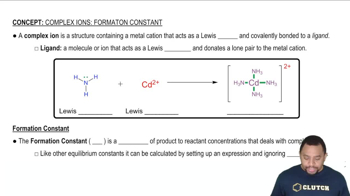Here are the essential concepts you must grasp in order to answer the question correctly.
Solubility Product Constant (Ksp)
The solubility product constant (Ksp) is an equilibrium constant that applies to the dissolution of sparingly soluble ionic compounds. It quantifies the extent to which a compound can dissolve in water, represented by the concentrations of its ions at equilibrium. For example, for PbCl2, Ksp is calculated from the concentrations of Pb²⁺ and Cl⁻ ions in solution, allowing us to understand its solubility behavior.
Recommended video:
Solubility Product Constant
Formation Constant (Kf)
The formation constant (Kf) is a measure of the stability of a complex ion in solution, representing the equilibrium between the complex and its constituent ions. It is defined for the reaction where ions combine to form a complex, such as Pb(OH)3⁻ in this case. A higher Kf value indicates a more stable complex, which is crucial for predicting the direction of the reaction and the concentrations of species at equilibrium.
Recommended video:
Complex Ions and Formation Constant
Equilibrium Constant (K)
The equilibrium constant (K) for a reaction is a ratio of the concentrations of products to reactants, each raised to the power of their coefficients in the balanced equation. It provides insight into the position of equilibrium and the extent of the reaction. In this case, the equilibrium constant for the given reaction can be derived from the Ksp and Kf values, allowing us to determine how the reaction favors the formation of products or reactants.
Recommended video:
 Verified step by step guidance
Verified step by step guidance


